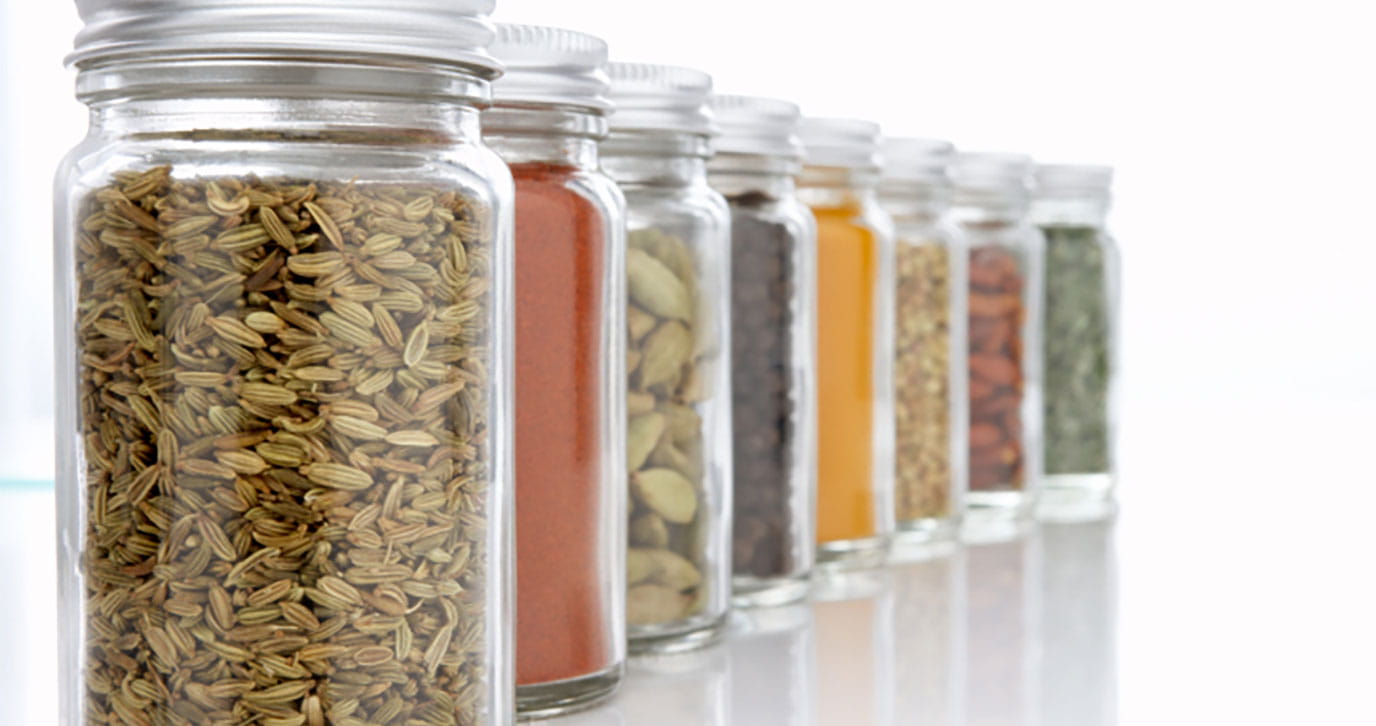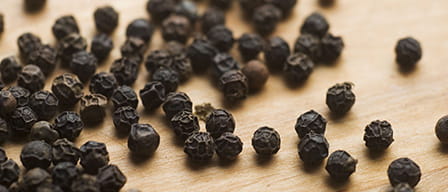
Anise


Nutmeg is a spice obtained from the Myristica fragrans Houtt. tree (family Myristicaceae) commonly called a nutmeg tree. This tropical, bushy evergreen tree usually grows up to a height of about 40 ft from which the seeds are harvested to produce the spice. The name nutmeg is derived from the Latin word nux muscatus, meaning “musky nut”. In Hindi nutmeg is call jaiphal. The Spanish call it moscada, in Arabic it is called jouza at-teeb, the Germans call it muskatnu, the French call it muscade, the Indonesians call it pala and the Chinese call it dou kou shu.
The tree is native to the Maluku Province, or Spice Islands, of Indonesia and is principally cultivated there and in the Caribbean islands of Grenada and Trinidad. The tree can yield fruit for 60 years or longer. The flowers are pale yellow, fleshy, waxy, and bell-shaped. The fruit is a lemon-yellow color and similar in appearance to an apricot or a peach. When fully mature it splits in two, exposing a scarlet-colored spongy covering (from which the spice mace is made), that surrounds a single brown nutmeg seed. After this covering is removed, the nutmegs are dried gradually in the sun during which time the seed coat dries and hardens. Finally, the shell is broken and the dried nutmeg kernels or seeds are harvested. Major constituents of the essential oil in nutmeg are sabinene, pinenes, β-caryophyllene and terpene alcohols. The chief flavor contributing components, myristicin and elemicin, are present in low concentrations.


The Romans used nutmeg as incense, due to its pungent fragrance, and would grate nutmeg to include in small, scented bags. In the 6th century, Arab merchants brought nutmegs to Constantinople and likely introduced them into Europe during the 12th century. Due to its purported insecticidal properties, the Holy Roman Emperor Henry VI ordered that the streets of Rome be dusted with nutmeg before his coronation in the twelfth century. The medieval author Chaucer mentions nutmeg in his Canterbury Tales, written toward the end of the 14th century. In the Middle Ages spices were incredibly popular and the culinary demand in Europe for them, including nutmeg, was enormous. Nutmeg powder was added to food and alcoholic drinks at medieval festivities. In fact, nutmeg was among those spices considered status symbols for the nobility of Europe and some ostentatious wealthy travelers would even carry their own pocket nutmeg grinders around with them to improve the flavor of their meals. Thus, it is no surprise that nutmeg became important as an expensive commercial spice in the Western world and that trade was exceptionally competitive. The Portuguese and Dutch conspired to keep prices high, while the English and French struggled to obtain seedlings for creating their own nutmeg crops. The Dutch even exchanged their colony of New Amsterdam, now New York City, for control of a British-owned nutmeg-producing island in Indonesia and thus ensure their nutmeg monopoly. The Dutch monopolized the trade in nutmeg until the 19th Century when the tree was planted in other regions and the Caribbean.
Nutmeg has a long history of usage in almost all the traditional medicinal systems. Referring to its native cultivation in the Banda islands of Indonesia, the Persian physician Ibn Sina, around 1000 AD, described this Banda nutmeg as jansi ban. During the Middle Ages, nutmeg was believed to have the power to ward off not only colds, but also deadly diseases such as bubonic plague. Apparently, while treating patients with the plague, some doctors would wear a mask filled with spices that included nutmeg, expecting it to offer needed protection. In Indian Ayurvedic medicine, nutmeg was used to treat anxiety, nausea, diarrhea, cholera, stomach cramps, parasites, paralysis, and rheumatism and also was used as an aphrodisiac. In Pakistan traditional medicine, the nutmeg plant was used to treat hypertension and depression and to regulate sexual disorders. In Malayan medicine nutmeg was recommended as a remedy for overeating, bloating, and madness, and for post-childbirth relief. In some African regions it also was traditionally used to treat digestive and respiratory tract illnesses. Nutmeg continues to find applications today. For example, nutmeg essential oils are incorporated in aromatherapy. The aromas of the main constituents of nutmeg are thought to act as stress relievers. Some companies in Japan circulate such aromas through air ventilation systems to improve the work environment, as well as enhance air quality. In Indonesia, nutmeg is still being used to treat rheumatism, kidney disorders, stomach cramps, nervousness, and whooping cough. In fact, nutmeg is often an ingredient in Jamu Beras Kencur, a popular Indonesian herbal drink traditionally used to treat maladies such as stiffness, pain, and fatigue.
When young, the nutmeg kernel is oval, pale brown, and soft, but it quickly shrivels when dried and becomes grayish brown with a furrowed surface.

Nutmeg has a distinctive, pungent fragrance and a warm, slightly sweet taste that may include fruity, citrus, floral, herbal, woody, and spicy notes. In fact, there appears to be individual variations as to how sweet nutmeg seems to smell and taste, which may be a function of different food cultures.
Nutmeg provides an intense, sweet, spicy aroma. Nowadays, nutmeg helps flavor quite a wide variety of foods such as baked goods and desserts, savory preparations, and diverse meat dishes. Nutmeg appears frequently in various Dutch dishes. It is in the Dutch spice mix speculaaskruiden and also flavors Dutch recipes for potatoes and other vegetables. Italians flavor spinach with nutmeg for stuffed pastas. Nutmeg’s warm flavor makes it a welcome spice for end of the year celebrations. For example, in England it is added to mince pies, Christmas pudding recipes, cakes and sweet creams, and Christmas brandy butter. It is found in quatre epices a popular French culinary spice mix that contains ground pepper, cloves, nutmeg, and dried ginger. In French cooking, quatre epices is typically used in soups, sauces (classic béchamel sauce), vegetable preparations and meat dishes. The Indian spice blend garam masala contains nutmeg, cumin, coriander, cardamom, cinnamon, cloves, and black pepper. Other aromatic spice blends of the Middle East and Asia also contain nutmeg. In Indonesia, nutmeg is used in sauces and curries, and the rind of the ripe fruit is used in pickles, and in the preparation of jellies, jams, and chutneys. The fruit also can be sliced finely, cooked and crystallized to make a fragrant candy snack called manisan pala. Half ripe fruits are candied in Malaysia as well. Nutmeg has become a popular spice in Caribbean cooking and is added to the jerk seasoning spice blend (allspice, pepper, garlic, onions, nutmeg, and brown sugar), pastries, ice creams, fruit punches, eggnogs, breads and cakes. The rind of the fruit also is used in Grenada to make a jam called morne delice. In North America, pumpkin spice (cinnamon, ginger, nutmeg, and cloves), the recipe for which dates back to the end of the 18th century, is the special flavor of fall and winter recipes and Thanksgiving dishes such as pumpkin pie, spice cakes and eggnog.
Although whole nutmeg is available, ground nutmeg is more popular. However, the spice in the ground form can readily lose its flavor. Therefore, grating nutmeg just before cooking or baking can ensure the best flavor.
Our understanding of how nutmeg and other spices and herbs potentially benefit health is growing. Using diverse spices and herbs as seasonings has been shown to unlock new flavors and tastes that enhance our enjoyment of numerous foods and vegetables, while reducing our intake of added saturated fats, sugar and sodium. Explore ways to incorporate various spices and herbs to create healthy meals and expand your culinary experiences. Learn about recommendations for building a balanced and healthy diet.

Anise

Basil

Bay Leaf

Black Pepper

Black Seed

Cardamom
